Smolensk Oblast
Smolensk Oblast (Russian: Смоле́нская о́бласть, Smolenskaya oblast; informal name — Smolenschina (Russian: Смоле́нщина)[14] is a federal subject of Russia (an oblast). Its administrative centre is the city of Smolensk. As of the 2010 Census, its population was 985,537.[10]
Smolensk Oblast | |
|---|---|
| Смоленская область | |
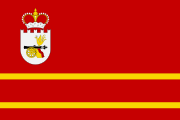 Flag 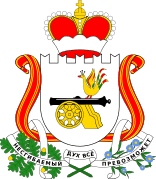 Coat of arms | |
| Anthem: [1] | |
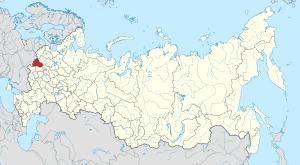 | |
| Coordinates: 55°00′N 33°00′E | |
| Country | Russia |
| Federal district | Central[2] |
| Economic region | Central[3] |
| Established | September 27, 1937[4] |
| Administrative center | Smolensk[5] |
| Government | |
| • Body | Oblast Duma[6] |
| • Governor[7] | Alexey Ostrovsky[8] |
| Area | |
| • Total | 49,800 km2 (19,200 sq mi) |
| Area rank | 53rd |
| Population (2010 Census)[10] | |
| • Total | 985,537 |
| • Estimate (2018)[11] | 949,348 (-3.7%) |
| • Rank | 53rd |
| • Density | 20/km2 (51/sq mi) |
| • Urban | 72.7% |
| • Rural | 27.3% |
| Time zone | UTC+3 (MSK |
| ISO 3166 code | RU-SMO |
| License plates | 67 |
| OKTMO ID | 66000000 |
| Official languages | Russian[13] |
| Website | http://admin-smolensk.ru/ |
Geography
The oblast was founded on 27 September 1937.[4] It borders Pskov Oblast in the north, Tver Oblast in the northeast, Moscow Oblast in the east, Kaluga Oblast in south, Bryansk Oblast in the southwest, and Mogilev and Vitebsk Oblasts of Belarus, in the west and northwest, as part of the Belarus–Russia border.
Hydrography
The main river of the region is the Dnieper River and its tributaries, Desna, Vop, Vyazma. By the rivers of the Volga basin and its tributary Vazuza Gzhat and tributary of the Oka river, Ugra. To the north-west flows a short section of the Western Dvina River and its tributary river Kasplya .
Among the major reservoirs supplying water are Moscow Vazuzssky Yauza and reservoirs in the north-east, as well as cooling power plants, Smolensk reservoir in the north near the village of Lake and Desnogorsk Reservoir in the south area of the city near the Desnogorsk .
Climate
The climate of Smolensk Oblast is humid continental, similar to the climate of Moscow Oblast, but slightly warmer in winter due to being located further west. Summers are short, warm and rainy, while winters are long, cold and snowy. Average temperatures range from −9 °C (16 °F) in January to 17 °C (63 °F) in July (although in the south it ranges from −8 °C (18 °F) in January to 18 °C (64 °F) in July). Annual precipitation varies from 630 to 730 millimeters per year.
Politics
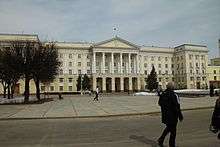
During the Soviet period, the high authority in the oblast was shared between three persons: The first secretary of the Smolensk CPSU Committee (who in reality had the biggest authority), the chairman of the oblast Soviet (legislative power), and the Chairman of the oblast Executive Committee (executive power). Since 1991, CPSU lost all the power, and the head of the Oblast administration, and eventually the governor was appointed/elected alongside elected regional parliament.
The Charter of Smolensk Oblast is the fundamental law of the region. The Legislative Assembly of Smolensk is the province's standing legislative (representative) body. The Legislative Assembly exercises its authority by passing laws, resolutions, and other legal acts and by supervising the implementation and observance of the laws and other legal acts passed by it. The highest executive body is the Oblast Government, which includes territorial executive bodies such as district administrations, committees, and commissions that facilitate development and run the day to day matters of the province. The Oblast administration supports the activities of the Governor who is the highest official and acts as guarantor of the observance of the oblast Charter in accordance with the Constitution of Russia.
Administrative divisions
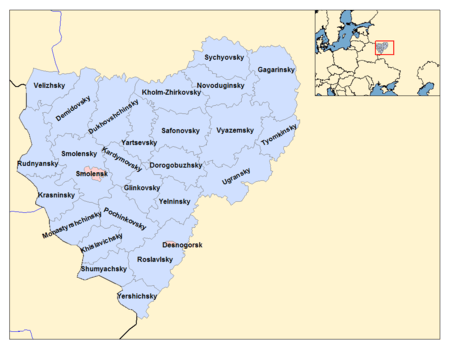
Smolensk Oblast is divided into 25 districts (raions) and 2 cities, which are further divided into 15 towns, 12 urban-type settlements, and 302 rural okrugs.
Demographics
Population: 985,537 (2010 Census);[10] 1,049,574 (2002 Census);[15] 1,158,299 (1989 Census).[16]
- 2012
2009 - 1.40 | 2010 - 1.38 | 2011 - 1.40 | 2012 - 1.43 | 2013 - 1.48 | 2014 - 1.53 | 2015 - 1.52 | 2016 - 1.52(e)
According to the 2010 Census, the ethnic composition of the oblast was as follows:[10]
- Russians: 94.6%
- Ukrainians: 1.3%
- Belarusians: 1.3%
- Armenians: 0.5%
- Others: 2.3%
- 41,457 people were registered from administrative databases, and could not declare an ethnicity. It is estimated that the proportion of ethnicities in this group is the same as that of the declared group.[19]
Religion
According to a 2012 survey[20] 19.5% of the population of Smolensk Oblast adheres to the Russian Orthodox Church, 7% are unaffiliated generic Christians, 3% are Orthodox Christian believers who do not belong to church or belong to other (non-Russian) Orthodox churches, 2% are Old Believers, 1% are adherents of the Slavic native faith (Rodnovery) movement, 0.4% are members of the Catholic Church. In addition, 45% of the population declares to be "spiritual but not religious", 13% is atheist, and 9.1% follows other religions or did not give an answer to the question.[20]
Notable people
- Isaac Asimov, born in Petrovichi
- Yuri Gagarin, born in Klushino
- Shmuel Schneersohn, born in Lyubavichi
- Ivan Sidorenko
- Andrey Nikolayevich Tikhonov born in Gagarin
- Mikhail Tukhachevsky
See also
- 2010 Polish presidential airplane crash
- Katyn massacre
- List of Chairmen of the Smolensk Oblast Duma
References
Notes
- Article 14 of the Charter of Smolensk Oblast states that the symbols of the oblast include a flag and a coat of arms, but not an anthem.
- Президент Российской Федерации. Указ №849 от 13 мая 2000 г. «О полномочном представителе Президента Российской Федерации в федеральном округе». Вступил в силу 13 мая 2000 г. Опубликован: "Собрание законодательства РФ", No. 20, ст. 2112, 15 мая 2000 г. (President of the Russian Federation. Decree #849 of May 13, 2000 On the Plenipotentiary Representative of the President of the Russian Federation in a Federal District. Effective as of May 13, 2000.).
- Госстандарт Российской Федерации. №ОК 024-95 27 декабря 1995 г. «Общероссийский классификатор экономических регионов. 2. Экономические районы», в ред. Изменения №5/2001 ОКЭР. (Gosstandart of the Russian Federation. #OK 024-95 December 27, 1995 Russian Classification of Economic Regions. 2. Economic Regions, as amended by the Amendment #5/2001 OKER. ).
- Исполнительный комитет Смоленского областного совета народных депутатов. Государственный архив Смоленской области. "Административно-территориальное устройство Смоленской области. Справочник", изд. "Московский рабочий", Москва 1981. Стр. 8
- Charter of Smolensk Oblast, Article 17
- Charter of Smolensk Oblast, Article 23
- Charter of Smolensk Oblast, Article 33
- Official website of Smolensk Oblast. Members of the Administration of Smolensk Oblast (in Russian)
- Федеральная служба государственной статистики (Federal State Statistics Service) (May 21, 2004). "Территория, число районов, населённых пунктов и сельских администраций по субъектам Российской Федерации (Territory, Number of Districts, Inhabited Localities, and Rural Administration by Federal Subjects of the Russian Federation)". Всероссийская перепись населения 2002 года (All-Russia Population Census of 2002) (in Russian). Federal State Statistics Service. Retrieved November 1, 2011.
- Russian Federal State Statistics Service (2011). "Всероссийская перепись населения 2010 года. Том 1" [2010 All-Russian Population Census, vol. 1]. Всероссийская перепись населения 2010 года [2010 All-Russia Population Census] (in Russian). Federal State Statistics Service.
- "26. Численность постоянного населения Российской Федерации по муниципальным образованиям на 1 января 2018 года". Federal State Statistics Service. Retrieved January 23, 2019.
- "Об исчислении времени". Официальный интернет-портал правовой информации (in Russian). June 3, 2011. Retrieved January 19, 2019.
- Official throughout the Russian Federation according to Article 68.1 of the Constitution of Russia.
- Смоленская область – Детальная интерактивная карта Смоленской области. Центральный ФО, Россия – регионы Есоседи. ru.esosedi.org (in Russian). Retrieved June 3, 2017.
- Russian Federal State Statistics Service (May 21, 2004). "Численность населения России, субъектов Российской Федерации в составе федеральных округов, районов, городских поселений, сельских населённых пунктов – районных центров и сельских населённых пунктов с населением 3 тысячи и более человек" [Population of Russia, Its Federal Districts, Federal Subjects, Districts, Urban Localities, Rural Localities—Administrative Centers, and Rural Localities with Population of Over 3,000] (XLS). Всероссийская перепись населения 2002 года [All-Russia Population Census of 2002] (in Russian).
- "Всесоюзная перепись населения 1989 г. Численность наличного населения союзных и автономных республик, автономных областей и округов, краёв, областей, районов, городских поселений и сёл-райцентров" [All Union Population Census of 1989: Present Population of Union and Autonomous Republics, Autonomous Oblasts and Okrugs, Krais, Oblasts, Districts, Urban Settlements, and Villages Serving as District Administrative Centers]. Всесоюзная перепись населения 1989 года [All-Union Population Census of 1989] (in Russian). Институт демографии Национального исследовательского университета: Высшая школа экономики [Institute of Demography at the National Research University: Higher School of Economics]. 1989 – via Demoscope Weekly.
- "Естественное движение населения в разрезе субъектов Российской Федерации". www.gks.ru.
- "Каталог публикаций::Федеральная служба государственной статистики". www.gks.ru.
- "ВПН-2010". www.perepis-2010.ru.
- "Arena: Atlas of Religions and Nationalities in Russia". Sreda, 2012.
- 2012 Arena Atlas Religion Maps. "Ogonek", № 34 (5243), 27/08/2012. Retrieved 21/04/2017. Archived.
Sources
- Смоленская областная Дума. Областной закон №37-з от 15 мая 2001 г. «Устав Смоленской области», в ред. Областного закона №162-з от 26 ноября 2015 г. «О поправке к уставу Смоленской области». Вступил в силу со дня официального опубликования. Опубликован: "Рабочий путь", №116–117, 24 мая 2001 г. (Smolensk Oblast Duma. Oblast Law #37-z of May 15, 2001 Charter of Smolensk Oblast, as amended by the Oblast Law #162-z of November 26, 2015 On the Amendment to the Charter of Smolensk Oblast. Effective as of the day of the official publication.).
External links
| Wikimedia Commons has media related to Smolensk Oblast. |
- Official website of Smolensk Oblast
- (in Russian) Official website of Smolensk Oblast
- (in Russian) News of Smolensk Oblast